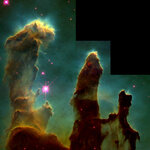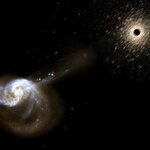Space
Clusters, the largest structures in the Universe, are comprised of many galaxies, like the Milky Way. One mystery about clusters is why the gas in the centers of some are rapidly cooling and condensing but not forming into stars. Until recently, no model existed that successfully explained how this was possible.
Evan Scannapieco, a theoretical astrophysicist and assistant professor in Arizona State University's School of Earth and Space Exploration in the College of Liberal Arts and Sciences, has spent much of his career studying the evolution of galaxies and clusters. "There are two types of…

Scientists in Hangzhou joined residents and tourists across China and India in observing the longest total solar eclipse in a century - and probably the most-viewed one ever. The moon's shadow traced a path across the world's two most populous countries for five minutes and 36 seconds, a treat for scientists and spectators alike.
"We saw it! The clouds kept getting thinner, and we even had a pretty good-sized hole in the clouds for the five minutes of totality," reported Expedition Leader Jay Pasachoff, Field Memorial Professor of Astronomy at Williams and chair of the…
Apollomania is sweeping the nation!
Well, not quite mania, perhaps just Apollostalgia. That's defined as showing an interest in the Apollo program history, while lacking the will to actually recommit to exploring space.
As we look at the 40th anniversary of humankind's first setting foot on a celestial body other than the Earth, I will state clearly that Apollo 12 was the peak of the Apollo program.
Now, it's true Apollo 11 is when humans first set foot on the moon. It's Apollo 11's anniversary, it's getting the lion's share of the attention right now.
But I…

Yesterday I wrote how Anthony Wesley, who hails from Canberra, Australia, grabbed this shot of a new dark spot near the south pole of Jupiter.
It's left to bigger minds (and bigger telescopes) than mine to sort out what caused it but while the blogosphere has been buzzing, JPL has been observing.
Preliminary image showing a black mark in Jupiters South Polar Region (SPR). Weather, moon shadow or huge meteor/asteroid/comet impact? Image captured by Anthony Wesley on 19th July 2009 at 1554UTC from Murrumbateman Australia
Initially, some speculated it could be weather. …

A team of astrophysicists has developed a new explanation for the early composition of our solar system - radioactive nuclei found in the earliest meteorites, dating back billions of years, could have been delivered by a nearby dying giant star of six times the mass of the sun.
If their hypothesis holds water, it could change our current ideas on the origin of the solar system.
"We have known about the early presence of these radioactive nuclei in meteorites since the 1960s, but we do not know where they originated from. The presence of the radioactive nuclei has been previously linked…

40 years ago, July 20, 1969, Apollo 11 Astronauts Neil Armstrong and Buzz Aldrin became the first humans to land on the moon, making the U.S. last to start but first to finish in the 'space race' with the Soviet Union. Armstrong's now famous words, "one small step for man, one giant leap for mankind," inspired a generation of scientists.
The new R&D enterprise it fostered, built to support America's geopolitical ambitions and based largely on federally-funded contracts and specifications rather than the private funding that had been the primary source of basic research…

Was there an impact on Jupiter or is that new dark spot just a temporary anomaly?
Anthony Wesley, who hails from Canberra, Australia, grabbed this shot of a new dark spot near the south pole of Jupiter. The great thing about astronomy is it's one of the last areas in science where 'amateurs' can still do great things before Big Science gets to it.
Nancy Atkinson at Universe Today says it's similar to the marks left by Comet P/Shoemaker-Levy 9 15 years back while Phil Plait at Discover says it's likely just weather.
Moon shadow? Nope, wrong place and wrong size, says Wesley…

The Eagle Nebula is a dazzling stellar nursery located 7000 light-years away near the constellation of Serpens - the Snake. In the Eagle Nebula, a region of gas and dust where young stars are currently being formed, a cluster of massive, hot stars named NGC 6611 has just been born.
The powerful light and strong winds from these massive new arrivals are shaping light-year long pillars, seen in the image partly silhouetted against the bright background of the nebula. The nebula itself has a shape vaguely reminiscent of an eagle, with the central pillars being the "talons".
The Eagle…

Just a short anecdote today, as I'm suffering from mind erasure. There's a rich history of ragging on management, ranging from Dilbert to The Daily WTF. As a card-carrying contrarian, I therefore bring you a tale of good leadership and upbeat endings within NASA.
The story starts out as inevitable tragedy. A NASA worker wins a federal award, but cannot attend the ceremony because she'll be at a different NASA center that week. She asks her higher up to accept the award on her behalf. And, of course, the higher up can now step in and take all the credit, eh?…

The cluster of stars surrounding a supermassive black hole after it has been ejected from a galaxy are a new kind of astronomical object, according to a paper published in Astrophysical Journal.
More importantly, the stars contain a 'fossil record' from the 'kicking' galaxy.
The paper discusses the hypothetical properties of 'hypercompact stellar systems' and suggests that hundreds of these faint star clusters might be detected at optical wavelengths in our immediate cosmic environment. Some of these objects may already have been picked up in astronomical surveys, reports David Merritt,…